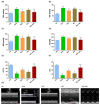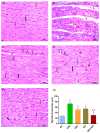Secukinumab and Black Garlic Downregulate OPG/RANK/RANKL Axis and Devitalize Myocardial Interstitial Fibrosis Induced by Sunitinib in Experimental Rats
- PMID: 36836664
- PMCID: PMC9962443
- DOI: 10.3390/life13020308
Secukinumab and Black Garlic Downregulate OPG/RANK/RANKL Axis and Devitalize Myocardial Interstitial Fibrosis Induced by Sunitinib in Experimental Rats
Abstract
Sunitinib has been associated with several cardiotoxic effects such as cardiac fibrosis. The present study was designed to explore the role of interleukin (IL)-17 in sunitinib-induced myocardial fibrosis (MF) in rats and whether its neutralization and/or administration of black garlic (BG), a form of fermented raw garlic (Allium sativum L.), could extenuate this adverse effect. Male Wistar albino rats received sunitinib (25 mg/kg three times a week, orally) and were co-treated with secukinumab (3 mg/kg, subcutaneously, three times total) and/or BG (300 mg/kg/day, orally) for four weeks. Administration of sunitinib induced significant increase in cardiac index, cardiac inflammatory markers, and cardiac dysfunction that were ameliorated by both secukinumab and BG, and to a preferable extent, with the combined treatment. Histological examination revealed disruption in the myocardial architecture and interstitial fibrosis in cardiac sections of the sunitinib group, which were reversed by both secukinumab and BG treatments. Both drugs and their co-administration restored normal cardiac functions, downregulated cardiac inflammatory cytokines, mainly IL-17 and NF-κB, along with increasing the MMP1/TIMP1 ratio. Additionally, they attenuated sunitinib-induced upregulation of the OPG/RANK/RANKL axis. These findings highlight another new mechanism through which sunitinib can induce interstitial MF. The current results propose that neutralizing IL-17 by secukinumab and/or supplementation with BG can be a promising therapeutic approach for ameliorating sunitinib-induced MF.
Keywords: IL-17; OPG/RANK/RANKL; black garlic; interstitial myocardial fibrosis; secukinumab; sunitinib.
Conflict of interest statement
The authors declare no conflict of interest.
Figures





Similar articles
-
Osteoprotegerin/RANK/RANKL axis in cardiac remodeling due to immuno-inflammatory myocardial disease.Exp Mol Pathol. 2008 Jun;84(3):213-7. doi: 10.1016/j.yexmp.2008.02.004. Epub 2008 Mar 7. Exp Mol Pathol. 2008. PMID: 18417124
-
Repurposing Secukinumab and Dapagliflozin as Candidate Therapies to Mitigate the Renal Toxicity of Sunitinib in Rats Through Suppressing IL-17-Mediated Pyroptosis and Promoting Autophagy.J Biochem Mol Toxicol. 2025 Mar;39(3):e70204. doi: 10.1002/jbt.70204. J Biochem Mol Toxicol. 2025. PMID: 40059817
-
IL-17 induces myocardial fibrosis and enhances RANKL/OPG and MMP/TIMP signaling in isoproterenol-induced heart failure.Exp Mol Pathol. 2009 Dec;87(3):212-8. doi: 10.1016/j.yexmp.2009.06.001. Epub 2009 Jun 13. Exp Mol Pathol. 2009. PMID: 19527710
-
Zinc supplements and bone health: The role of the RANKL-RANK axis as a therapeutic target.J Trace Elem Med Biol. 2020 Jan;57:126417. doi: 10.1016/j.jtemb.2019.126417. Epub 2019 Oct 11. J Trace Elem Med Biol. 2020. PMID: 31653549 Review.
-
S-Allyl cysteine in garlic (Allium sativum): Formation, biofunction, and resistance to food processing for value-added product development.Compr Rev Food Sci Food Saf. 2022 May;21(3):2665-2687. doi: 10.1111/1541-4337.12937. Epub 2022 Mar 30. Compr Rev Food Sci Food Saf. 2022. PMID: 35355410 Review.
Cited by
-
Experimental Insights on the Use of Secukinumab and Magnolol in Acute Respiratory Diseases in Mice.Biomedicines. 2024 Jul 11;12(7):1538. doi: 10.3390/biomedicines12071538. Biomedicines. 2024. PMID: 39062111 Free PMC article.
-
Targeting Common Inflammatory Mediators in Experimental Severe Asthma and Acute Lung Injury.Pharmaceuticals (Basel). 2024 Mar 5;17(3):338. doi: 10.3390/ph17030338. Pharmaceuticals (Basel). 2024. PMID: 38543124 Free PMC article.
-
The role of IL-17 family cytokines in cardiac fibrosis.Front Cardiovasc Med. 2024 Oct 22;11:1470362. doi: 10.3389/fcvm.2024.1470362. eCollection 2024. Front Cardiovasc Med. 2024. PMID: 39502194 Free PMC article. Review.
References
Grants and funding
LinkOut - more resources
Full Text Sources
Research Materials
Miscellaneous

